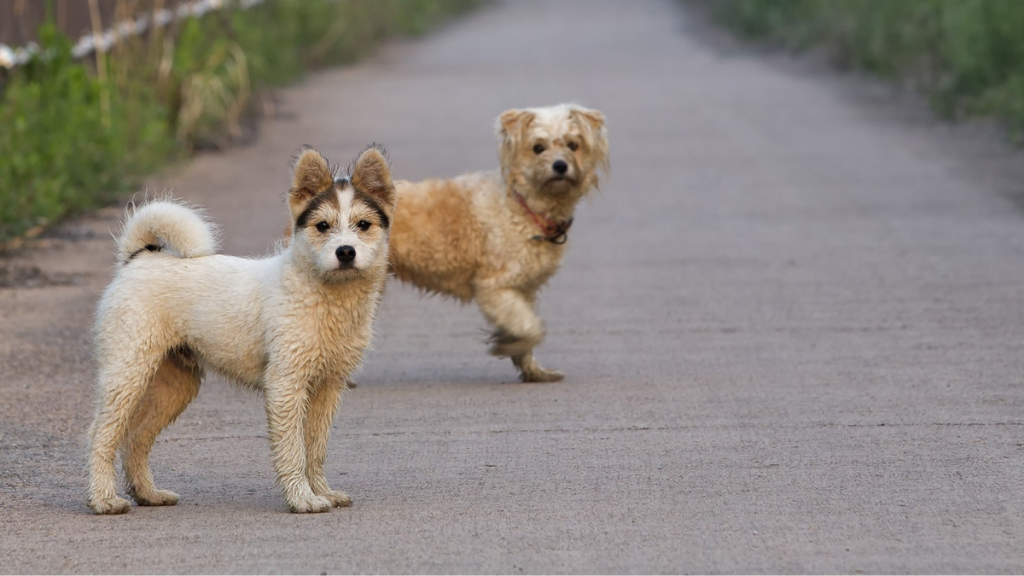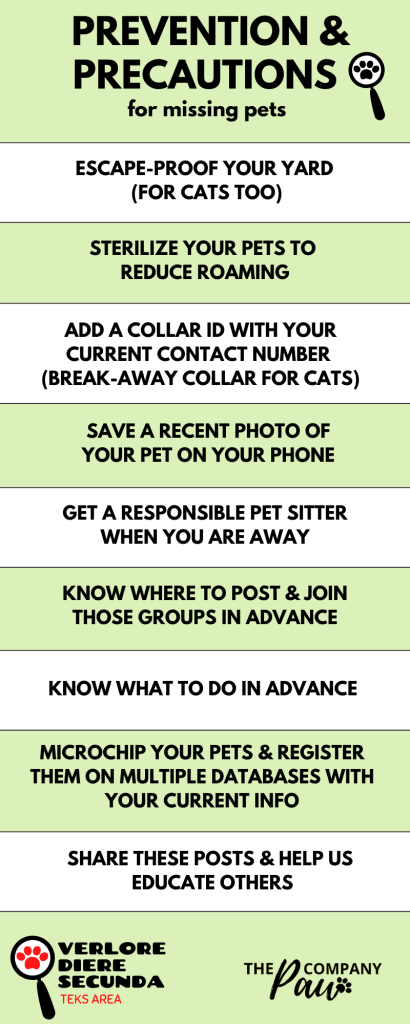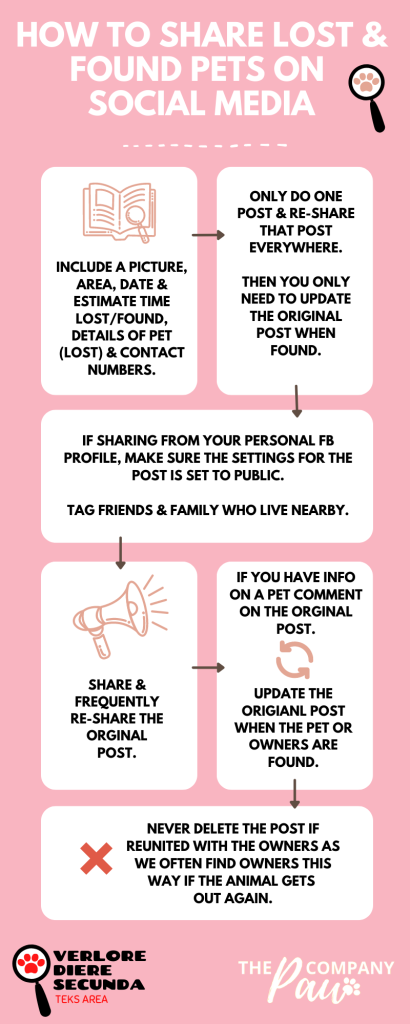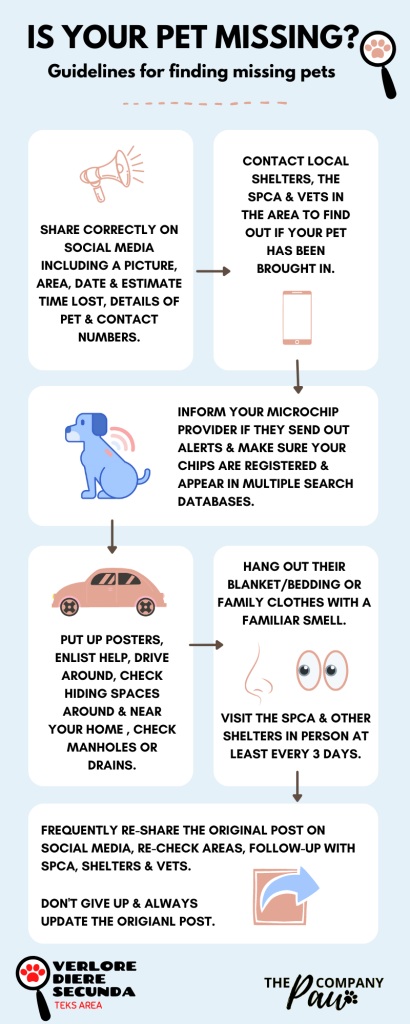
WHAT CAN YOU DO TO FIND YOUR MISSING PET?
Missing pets are shared on socia meida daily and it is a rising concern for us in animal welfare. There are so many animals in the streets and although there are some exceptions, most of them are shockingly allowed outside by their owners, including cats. We can share horror stories on why this is dangerous and irresponsible and how many never came home. How the one you thought was “streetwise” was hit by a car or the one you say “knows his way home”, stopped returning home. If you think the streets are unsafe for your child, why would it be safe for your pets?
When your pets roam the streets, they also become a nuisance to others and sadly the cruelty against animals increases because of this e.g. poisoning and shootings. Other dangers include being attacked by animals or humans or stolen for dog fights, re-selling or breeding and more. That is apart from the dangers of cold nights which seem to be here already! Millions of animals enter shelters every year in mainly three ways: Surrendered by owners, confiscated legally from owners, or brought in as strays by good samaritans.

Why do animals engage in this behaviour?
- Trying to get home – have you recently moved?
- Your dog’s habit
- Mating
- Loneliness & boredom
- Your dog is scared & had a fright
- Something excites them
- It’s easy to get out
The above can be addressed or prevented by:
- Create a safe, secure and familiar environment.
- Meet their needs with exercise and enrichment.
- Spay/neuter your pets.
- Don’t leave them alone for too long, especially social animals.
- Some behaviour might require training and patience.
- Teach them not to go out of the yard without you, even if the gate is open.
- There are many ways to keep your cats safe in your yard. This includes PVC roller bars, angled fences, catios and more.
Also, read how to escape-proof your yard.
TIP for in case they get lost – make sure you have a good full body photo of your pet to share when they are lost. You can even make a flyer in advance. Microchip them (collar ID too) and register the microchip on more than one database with up-to-date details.



SHARE MISSING PETS CORRECTLY ON SOCIAL MEDIA TO IMPROVE THE CHANCES OF FINDING THEM.
- Share a clear full body picture (preferably only one because of how it might appear groups and timelines)
- Share this post on your personal profile with the privacy setting on public. Include a photo, sex of pet details, specific identifying marks, the area lost, the date, during which time frame and a contact number (another alternative number is even better).
- Don’t put these details in the comments, but everything in the original post.
- Then share that post to all groups and pages. Now people can share it out from private groups, which can’t be done otherwise and you only have one post to follow and to update.
- Always comment on and share the original post from social media as well as UPDATE the post if FOUND.
- Messenger is not an ideal place to be contacted due to message requests not being a formal notification for non-friends. We have lost so much time, not getting in touch with these people. I, for one, do not mind sharing my number on Facebook when the life of my fur-kid is at stake. It is a priority for me.
- Please take recent photos of your pets. As someone who loves animals, I don’t get how people don’t have any photos of their missing pets or they use old ones which does not even look as much like the pet now.
DO YOU HAVE A MISSING PET – WHAT CAN YOU DO?
- Act immediately and start searching as soon as you realize your pet is lost.
- Share on your local social media pages or groups & neighbourhood watch.
- Contact other local welfare organizations.
- Drive around in your area, put posters up, hand out flyers, and search manholes, fields, green strips, parks, ditches, complexes, churches, community buildings, schools, petrol stations, near shops or other hiding spaces.
- Ask neighbours if you can search on their property.
- Keep your phone charged.
- Re-check spots.
- Contact your local Vets to see if an animal has been brought in hurt or deceased.
- Don’t give up. Some pets were reunited with their owners after months and even years.
- Vary your search times. Try and call for pets at night as sound travels further. Cats are more active at night, while dogs might be more during the day.
- Some suggest putting out cats’ litter boxes or pets’ blankets as scent could help them find their way home.
- If your cat is used to being outside or your pet is missing for more days, expand your search radius.
- You can offer a reward, but keep in mind it does create a future incentive for pet theft so it is not ideal.
- Birds tend to fly when their adrenaline levels are high. They generally fly up to the highest point they can land. Most pet birds today have never fully fledged, so larger parrots require more skill to be able to take off, land, navigate where they want to go, or climb down. You will have to wait until the bird is ready to come down. Read more on missing bird guidelines here.
- Phone your local SPCA and send them an email with a picture & detailed description. Remember they have many animals coming in daily and various volunteers, so it is still best to visit them in person and multiple times. They may not advertise the animal in the first 5-day pound period.
- Continue to follow up with the SPCA and other organizations as well as continue to share the original post again.
Also, read more on how to be a responsible pet owner.
We would like to see one formal lost & found group for Secunda instead of all the separate groups created by the public. The groups I focus on include:
- Verlore diere Secunda (TEKS) (group). This is the only group in Secunda, run by those actively involved in animal welfare.
- Join the local WhatsApp group for lost and found pets here.
- Lost and found PETS Bethal.
- Verlore Diere Standerton
Next week we will look at what to do when you find an animal.
WHEN YOU KNOW BETTER, DO BETTER!